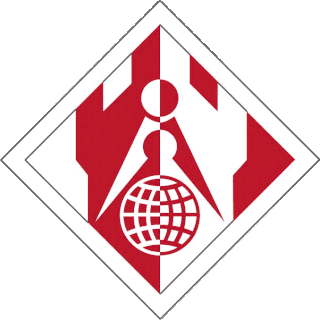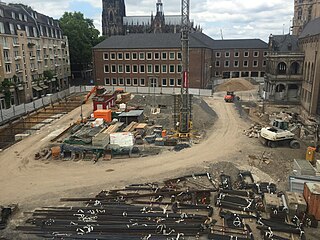Fifty civil engineering feats in Turkey or more formally 50 works in 50 years is a list published in 2005 by the Turkish Chamber of Civil Engineers about fifty prestigious projects of the civil engineering in Turkey. The list has five subsections about regional development, general purpose buildings, transportation, hydrology and industrial buildings. [1]
The Chamber of Civil Engineers department of the Union of Chambers of Turkish Engineers and Architects created the list on the 50th anniversary of the organization to enhance awareness in Turkish society about the achievements in the field of civil engineering. In line with this goal, a jury consisting of ten people from different professions, each in their field of expertise, was formed and the process of compiling, evaluating and selecting 50 works began.
On 31 August 2005, all suggestions were consolidated, a collective recommendation list was prepared and evaluation studies were started by the jury members. During the evaluations, it was adopted in principle that the works to be considered should be divided into sections of the field of expertise within the framework of the general grouping principle and that the works within the scope of all civil engineering specialization branches should be evaluated in this project.

Civil engineering is a professional engineering discipline that deals with the design, construction, and maintenance of the physical and naturally built environment, including public works such as roads, bridges, canals, dams, airports, sewage systems, pipelines, structural components of buildings, and railways.
An expert witness, particularly in common law countries such as the United Kingdom, Australia, and the United States, is a person whose opinion by virtue of education, training, certification, skills or experience, is accepted by the judge as an expert. The judge may consider the witness's specialized opinion about evidence or about facts before the court within the expert's area of expertise, to be referred to as an "expert opinion". Expert witnesses may also deliver "expert evidence" within the area of their expertise. Their testimony may be rebutted by testimony from other experts or by other evidence or facts.

The United States Army Corps of Engineers (USACE) is an engineer formation of the United States Army that has three primary mission areas: Engineer Regiment, military construction, and civil works. The day-to-day activities of the three mission areas are administered by a lieutenant general known as the commanding general/chief of engineers. The chief of engineers commands the Engineer Regiment, comprising combat engineer, rescue, construction, dive, and other specialty units, and answers directly to the Chief of Staff of the Army. Combat engineers, sometimes called sappers, form an integral part of the Army's combined arms team and are found in all Army service components: Regular Army, National Guard, and Army Reserve. Their duties are to breach obstacles; construct fighting positions, fixed/floating bridges, and obstacles and defensive positions; place and detonate explosives; conduct route clearance operations; emplace and detect landmines; and fight as provisional infantry when required. For the military construction mission, the commanding general is directed and supervised by the Assistant Secretary of the Army for installations, environment, and energy, whom the President appoints and the Senate confirms. Military construction relates to construction on military bases and worldwide installations.
Fred Arthur Leuchter Jr. is an American manufacturer of execution equipment, and a Holocaust denier best known as the author of the Leuchter report, a pseudoscientific document alleging there were no gas chambers at Auschwitz-Birkenau. Prior to the document's publication, he was contracted by authorities of several U.S. states to improve the designs of instruments for capital punishment. He was charged in Massachusetts with misrepresenting himself to penitentiaries as an engineer, despite having no relevant qualifications. He plea bargained with state prosecutors and received two years' probation. He has also been accused of running a "death row shakedown", where he threatened to testify for the defense in capital cases if he was not given contracts for his services by that state.

A civil engineer is a person who practices civil engineering – the application of planning, designing, constructing, maintaining, and operating infrastructure while protecting the public and environmental health, as well as improving existing infrastructure that may have been neglected.

Construction is a general term meaning the art and science to form objects, systems, or organizations, and comes from Latin constructio and Old French construction. To construct is the verb: the act of building, and the noun is construction: how something is built, the nature of its structure.

The American Society of Civil Engineers (ASCE) is a tax-exempt professional body founded in 1852 to represent members of the civil engineering profession worldwide. Headquartered in Reston, Virginia, it is the oldest national engineering society in the United States. Its constitution was based on the older Boston Society of Civil Engineers from 1848.

Anıtkabir is the mausoleum of Mustafa Kemal Atatürk, the leader of the Turkish War of Independence and the founder and the first President of the Republic of Turkey. It is located in Ankara and was designed by architects Professor Emin Onat and Assistant Professor Ahmet Orhan Arda, whose proposal beat 48 other entries from several countries in a competition held by the Turkish Government in 1941 for a monument for Atatürk.
Project engineering includes all parts of the design of manufacturing or processing facilities, either new or modifications to and expansions of existing facilities. A "project" consists of a coordinated series of activities or tasks performed by engineers, designers, drafters and others from one or more engineering disciplines or departments. Project tasks consist of such things as performing calculations, writing specifications, preparing bids, reviewing equipment proposals and evaluating or selecting equipment and preparing various lists, such as equipment and materials lists, and creating drawings such as electrical, piping and instrumentation diagrams, physical layouts and other drawings used in design and construction. A small project may be under the direction of a project engineer. Large projects are typically under the direction of a project manager or management team. Some facilities have in house staff to handle small projects, while some major companies have a department that does internal project engineering. Large projects are typically contracted out to engineering companies. Staffing at engineering companies varies according to the work load and duration of employment may only last until an individual's tasks are completed.

The U.S. Army Edgewood Chemical Biological Center (ECBC) is the United States's principal research and development resource for non-medical chemical and biological (CB) defense. As a critical national asset in the CB defense community, ECBC supports all phases of the acquisition life-cycle ― from basic and applied research through technology development, engineering design, equipment evaluation, product support, sustainment, field operations and demilitarization ― to address its customers’ unique requirements.
The Port of Mersin, is a major seaport located on the north-eastern coast of Mediterranean Sea in Mersin, southern Turkey. As one of the largest harbors in the country, it is Turkey's main gateway to the Mediterranean Sea. It was constructed during the 1950s as a major government project. It is the country's second largest port after Ambarli, near Istanbul. Owned by the Turkish State Railways (TCDD), its operating right is transferred on May 11, 2007 to PSA – Akfen consortium for a period of 36 years.
The Chamber of Electrical Engineers of Turkey was established in 1954. It is one of the 23 members of the confederation named Union of chambers of Turkish engineers and architects.

Mersin Halkevi is a building in Mersin, Turkey originally built within the scope of the project Halkevleri, but currently used as a cultural center and opera house.
Şanlıurfa Irrigation tunnels is the name of a major irrigation tunnel constructed in connection with the Southeastern Anatolia Project, a multi-sector integrated regional development project of Turkey. The tunnels were commissioned by the State Hydraulic Works authority (DSİ). The constructor was Eren İnşaat. The construction ended by 19 December 2005 and the tunnels were put into service.

Kahramanlar Business Center, originally known between 1959 and 2015 as Emek Business Center, is a 24 storey highrise building at Kızılay Square in Ankara, Turkey.

Yeşilçay Drinking Water Plant is a plant used to supply drinking water to İstanbul, Turkey.
The Faculty of Arts and Sciences (FAS) Building of Istanbul University is one of the larger faculty buildings of the university. It is situated in the Laleli neighborhood of Istanbul, Turkey.
Geoprofessions is a term coined by the Geoprofessional Business Association to connote various technical disciplines that involve engineering, earth and environmental services applied to below-ground (“subsurface”), ground-surface, and ground-surface-connected conditions, structures, or formations. The principal disciplines include, as major categories:

The Birecik Bridge is a 695 m (2,280 ft) long deck arch bridge carrying the D.400 across the Euphrates in Birecik, Turkey.
Lower Seyhan Irrıgation Project is one of the major irrigation projects of Turkey, which is located in the Seyhan River basin.